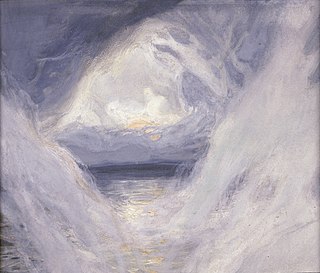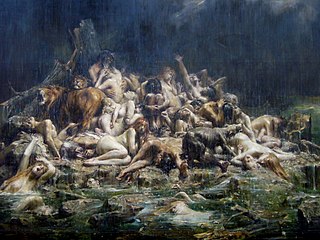
A creation myth or cosmogonic myth is a type of cosmogony, a symbolic narrative of how the world began and how people first came to inhabit it. While in popular usage the term myth often refers to false or fanciful stories, members of cultures often ascribe varying degrees of truth to their creation myths. In the society in which it is told, a creation myth is usually regarded as conveying profound truths – metaphorically, symbolically, historically, or literally. They are commonly, although not always, considered cosmogonical myths – that is, they describe the ordering of the cosmos from a state of chaos or amorphousness.

Noah appears as the last of the Antediluvian patriarchs in the traditions of Abrahamic religions. His story appears in the Hebrew Bible, the Quran and Baha'i writings. Noah is referenced in various other books of the Bible, including the New Testament, and in associated deuterocanonical books.

Aztec mythology is the body or collection of myths of the Aztec civilization of Central Mexico. The Aztecs were Nahuatl-speaking groups living in central Mexico and much of their mythology is similar to that of other Mesoamerican cultures. According to legend, the various groups who became the Aztecs arrived from the North into the Anahuac valley around Lake Texcoco. The location of this valley and lake of destination is clear – it is the heart of modern Mexico City – but little can be known with certainty about the origin of the Aztec. There are different accounts of their origin. In the myth, the ancestors of the Mexica/Aztec came from a place in the north called Aztlan, the last of seven nahuatlacas to make the journey southward, hence their name "Azteca." Other accounts cite their origin in Chicomoztoc, "the place of the seven caves", or at Tamoanchan.

Noah's Ark is the boat in the Genesis flood narrative through which God spares Noah, his family, and examples of all the world's animals from a global deluge. The story in Genesis is based on earlier flood myths originating in Mesopotamia, and is repeated, with variations, in the Quran, where the Ark appears as Safinat Nūḥ and al-fulk. The myth of the global flood that destroys all life begins to appear in the Old Babylonian Empire period. The version closest to the biblical story of Noah, as well as its most likely source, is that of Utnapishtim in the Epic of Gilgamesh.

Ayida-Weddo, also known as Ayida, Agida, Ayida-Wedo, Aido Quedo, Aido Wedo, Aida Wedo, and Aido Hwedo, is a powerful loa spirit in Vodou, revered in regions across Africa and the Caribbean, namely in Benin, Suriname and Haiti. Known as the "Rainbow Serpent", Ayida-Weddo is the loa of fertility, rainbows, wind, water, fire, wealth, thunder, and snakes. Alongside Damballa, Ayida-Weddo is regarded among the most ancient and significant loa. Considered in many sources as the female half of Damballa's twin spirit, the names Da Ayida Hwedo, Dan Ayida Hwedo, and Dan Aida Wedo have also been used to refer to her. Thought to have existed before the Earth, Ayida-Weddo assisted the creator goddess Mawu-Lisa in the formation of the world, and is responsible for holding together the Earth and heavens. Ayida-Weddo bestows love and well-being upon her followers, teaching fluidity and the connection between body and spirit.
The Tupi-Guarani mythology is the set of narratives about the gods and spirits of the different Tupi-Guarani peoples, ancient and current. Together with the cosmogonies, anthropogonies and rituals, they form part of the religion of these peoples.

Cherokee spiritual beliefs are held in common among the Cherokee people – Native American peoples who are Indigenous to the Southeastern Woodlands, and today live primarily in communities in North Carolina, and Oklahoma. Some of the beliefs, and the stories and songs in which they have been preserved, exist in slightly different forms in the different communities in which they have been preserved. But for the most part, they still form a unified system of theology.

Mythology of the Haudenosaunee includes the creation stories and folktales of the Native Americans who formed the confederacy of the Five Nations Iroquois, later the Six Nations Iroquois Confederacy. Historically, these stories were recorded in wampum and recited, only being written down later. In the written versions, the spellings of names differ due to transliteration and spelling variations in European languages that were not yet standardized. Variants of the stories exist, reflecting different localities and times.

The cosmic egg, world egg or mundane egg is a mythological motif found in the cosmogonies of many cultures and civilizations, including in Proto-Indo-European mythology. Typically, there is an egg which, upon "hatching", either gives rise to the universe itself or gives rise to a primordial being who, in turn, creates the universe. The egg is sometimes lain on the primordial waters of the Earth. Typically, the upper half of the egg, or its outer shell, becomes the heaven (firmament) and the lower half, or the inner yolk, becomes the Earth. The motif likely stems from simple elements of an egg, including its ability to offer nourishment and give rise to new life, as is reflected by the Latin proverb omne vivum ex ovo.
The evil twin is an antagonist found in many different fictional genres. The twin is physically nearly identical to the protagonist, but with a radically inverted morality. In films, they may have a symbolic physical difference from the protagonist—such as a goatee beard, eyepatch, scar, or distinctive clothing—which makes it easy for the audience to visually identify the two characters. Sometimes, however, the physical differences between the characters will be minimized, so as to confuse the audience. Both roles are almost always played by either the same actor or the actor's actual twin.
Mawu-Lisa is a creator goddess, associated with the Sun and Moon in Gbe mythology and West African Vodun. Mawu and Lisa are divine twins. According to the myths, she is married to the male god Lisa. Mawu and Lisa are the children of Nana Buluku, and are the parents of Oba Koso (Shango), known as Hebioso among the Fon.

Eve is a figure in the Book of Genesis in the Hebrew Bible. According to the origin story of the Abrahamic religions, she was the first woman. Eve is known also as Adam's wife.
The Lozi people believed in a creator god, whom the Lozi call Nyambe. Nyambe's wife was Nasilele and his mother was Ngula. Nyambe is said to have created both his wife and his mother. He is also said to have created everything else that exists, including the heaven, the Earth and all the plants and animals.
Mbombo, also called Bumba, is the creator god in the religion and mythology of the Kuba people of Central Africa in the area that is now known as Democratic Republic of the Congo. In the Mbombo creation myth, Mbombo was a giant in form and white in color. The myth describes the creation of the universe from nothing.
The Mandé creation narrative is the traditional creation myth of the Mandinka of southern Mali.

The Ainu historically have their own language and a rich repertoire of oral literature. The stories are particularly delivered through the genre of Kamui Yukar, which are long narratives of heroic exploits involving spiritual beings such as animals, plants, and natural phenomena. As result of assimilation, most of the Ainu people are Japanese speakers and do not speak the Ainu language. The literature now exists in forms of written texts which have been fixed but still remain to be many versions of the same tales. The Ainu creation myths are the traditional creation accounts of the Ainu peoples of Japan. These myths reflect the Ainu worldview that attributes subjectivity and agency to nonhuman entities, considering them as conscious beings with the ability to communicate and interact with humans. Although Ainu mythology has characteristics in common with the Japanese, whom they have interacted with for since the early 19th century, their creation myth remains their own.

The mythology of Indonesia is very diverse, the Indonesian people consisting of hundreds of ethnic groups, each with their own myths and legends that explain the origin of their people, the tales of their ancestors and the demons or deities in their belief systems. The tendency to syncretize by overlying older traditions with newer foreign ideas has occurred. For example, the older ancestral mythology might be merged with foreign mythology, such as Hindu, Islam, or Christian biblical mythology.
The Serer creation myth is the traditional creation myth of the Serer people of Senegal, the Gambia and Mauritania. Many Serers who adhere to the tenets of the Serer religion believe these narratives to be sacred. Some aspects of Serer religious and Ndut traditions are included in the narratives contained herein but are not limited to them.

The Genesis flood narrative is a Hebrew flood myth. It tells of God's decision to return the universe to its pre-creation state of watery chaos and remake it through the microcosm of Noah's ark.
Bemba is the creator god in the traditional religion of the Bambara people of Mali. The name is used to refer to Bemba, who is portrayed as a god consisting of four distinct beings and is sometimes used to refer to one of its members, Pemba. Although Bemba is often referred to as male, the union of these four beings as Bemba is hermaphroditic, with the male aspects represented by Pemba and Ndomadyiri, while the female aspects are represented by Nyale and Faro.











